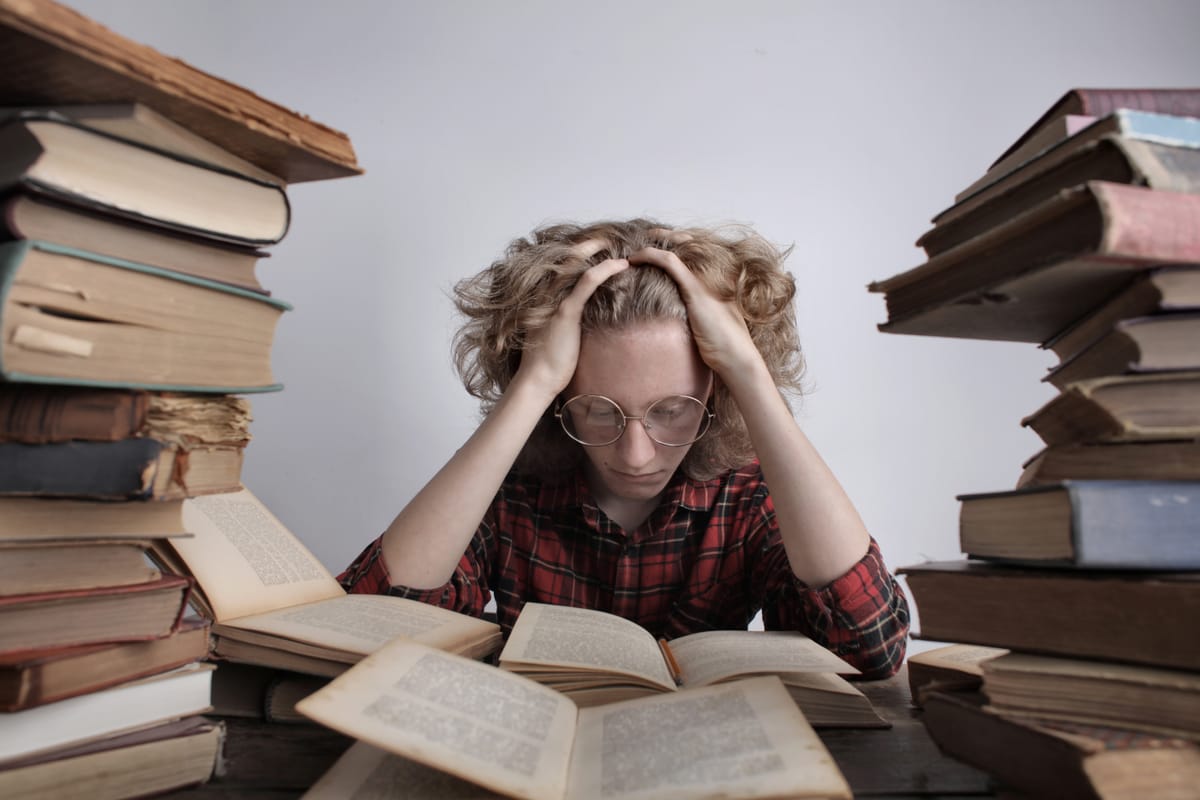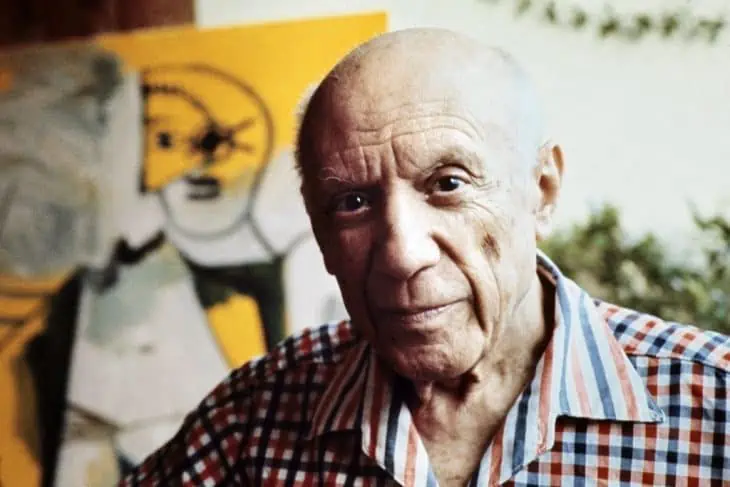
Pablo Picasso is one of the most influential artists of the 20th century. Before reaching the age of 50, the Spanish-born icon had established himself as a force to be reckoned with in the field of modern art. All and any other lists of Pablo Picasso facts would also definitely say so! Ever since Picasso was in school, his brilliance as a painter overshadowed his bad performance in other subjects. He eventually moved to France to work professionally as an artist. Throughout the course of his long career, he made around 20,000 paintings, sketches, sculptures, and pottery pieces.
His ability to create art in a wide range of styles made him very popular. One style he popularized was the Cubist movement, which he founded along with fellow artist Georges Braque. Cubism was an avant-garde art movement that forever changed the face of European painting and sculpture. In Cubism, artists disassembled and reassemble subjects and objects in an abstract fashion. Unbeknownst to them, when Picasso and Braque were creating the groundwork for Cubism, its influence turned out to be so far-reaching, it gave birth to various styles. These styles eventually became popular in other nations.
In a nutshell, Picasso took what started in the 19th century, when artists first broke with classical art and defined art for the whole of the 20th century. What a truly amazing man! Learn more about this great pioneer of the modern art world. Check out our 40 Pablo Picasso Facts below.
- Pablo Picasso dominated European art as early as 1914.
- Scholars estimate Picasso produced at least 50,000 pieces of art in his lifetime.
- They also estimate he made at least two pieces of art every day at the height of his career.
- Pablo Picasso’s made 1,885 paintings, 2,880 ceramics, 1,228 sculptures, and about 12,000 drawings throughout his life.
- Simple drawings alone make up an estimated 12,000 pieces of Picasso’s art.
- Pablo Picasso came from Malaga in Andalusia, Southern Spain.
- Picasso’s father began teaching him how to draw and paint at the age of 7.
- Picasso later entered Barcelona’s School of Fine Arts in 1895 at the age of only 13.
- He also later entered Madrid’s Real Academy de Bellas Artes de San Fernando but left without finishing his course.
- Picasso first visited Paris in 1900 but returned to Madrid a year later.
- Together with his friend Guillaume Apollinaire, Picasso became a suspect in the 1911 theft of the famous painting Mona Lisa.
- He also began working with the art dealer Paul Rosenberg at this time.
- Picasso stayed in Paris during WWII.
- He died during dinner from pulmonary edema and heart failure on April 8, 1973.
- His grave lies at the Chateau of Vauvenargues near Aix-en-Provence.
- Early in his career, Picasso enjoyed a friendly rivalry with Fauvist artist Henri Mattise.
- Picasso avoided using professional models for his art.
- At the height of his career, Picasso’s peers considered him the greatest artist alive.
- The Louvre gave Pablo Picasso a special exhibition on his 90th birthday in 1971.
- Only American artist Bob Ross rivals Picasso’s number of works.
Pablo Picasso’s father taught art in school.
Don Jose Ruiz y Blanco did so at Malaga’s School of Crafts. He also doubled as a curator for a local museum. Don Jose made art, too. He was a naturalist painter specializing in the reproduction of birds and other animals. Don Jose became Picasso’s first art teacher and later claimed to have abandoned art after his son surpassed him at the age of 7. Scholars consider this a myth, as records show signed artwork by Don Jose existing past this point.
Picasso’s art career started early.
Barcelona’s Museu Picasso holds his oldest artwork, dating back to the 1890s. Scholars consider this collection the most complete for the beginning of any artist’s career. They also consider his pieces from the early 1890s as having something of a juvenile career, with Picasso only beginning to make waves in 1894. Two of his most famous works include The First Communion, a painting of his older sister, Lola. There’s also Portrait of Aunt Pepa, created in 1896 in the realism style.

Scholars call the first phase of Picasso’s career the Blue Period.
The name comes from how Picasso mainly used blue or blue-green paint for his paintings, from 1901 to 1904. The dark colors matched the theme of his work at this time, usually showing prostitutes, beggars, and other scenes of poverty. Scholars believe the dark and depressing themes of this period of Picasso’s career reflect his own feelings at the time due to his friend Carles Casagemas’ suicide. Two of his most famous work are La Vie and The Old Guitarist.
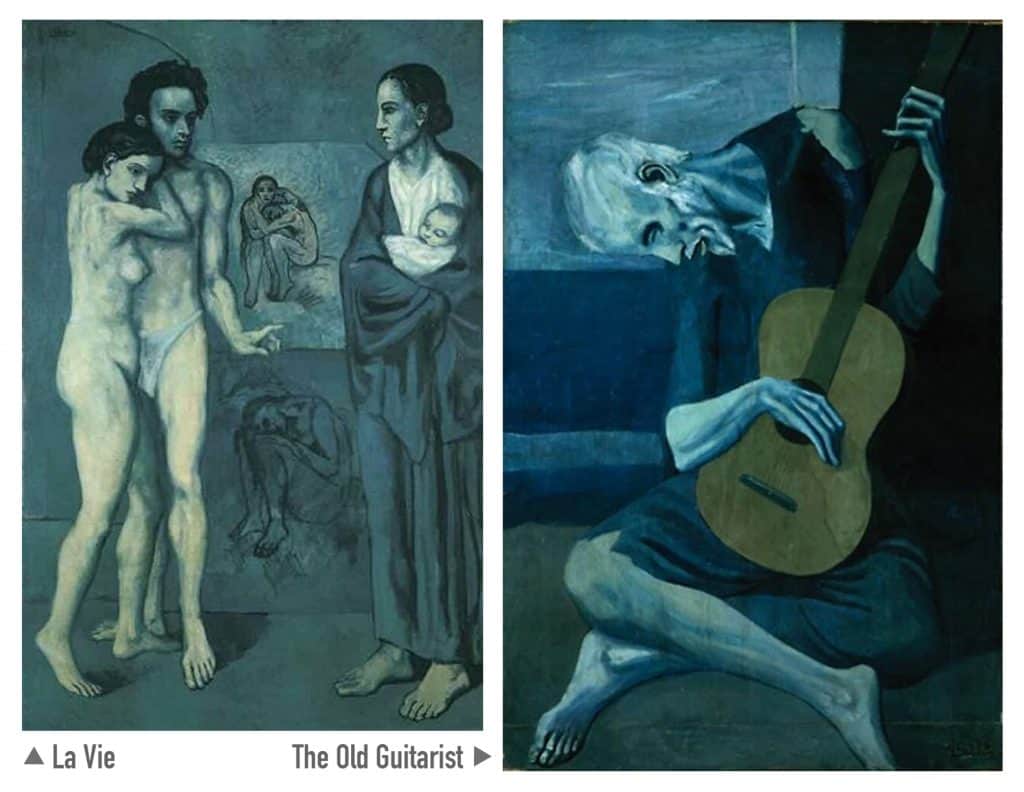
The Rose Period followed the Blue Period.
The name comes from Picasso mainly using orange and pink paint for his paintings from 1904 to 1906. The brighter colors also came with brighter themes, with his work now showing more cheerful settings, such as acrobats, circuses, and harlequins.
In fact, Picasso first adopted a harlequin as his personal symbol at that time, and would use it for decades to come. His first mistress, fellow artist Fernande Olivier, also became a model for at least 60 portraits from this period of his career. Two of the most famous pieces of Picasso from this time include Au Lapin and Portrait of Gertrude Stein.
Picasso experimented with African art with his work Les Demoiselles d’Avignon.
He first painted the work based on the dominant trends for Iberian sculpture at the time but repainted the heads of the women after seeing some African sculptures on exhibit. The painting met poor reception from Picasso’s peers, with his friendly rival Henri Mattise even describing the painting as a hoax. This led Picasso to not put up the painting for display for almost a decade, until 1916.
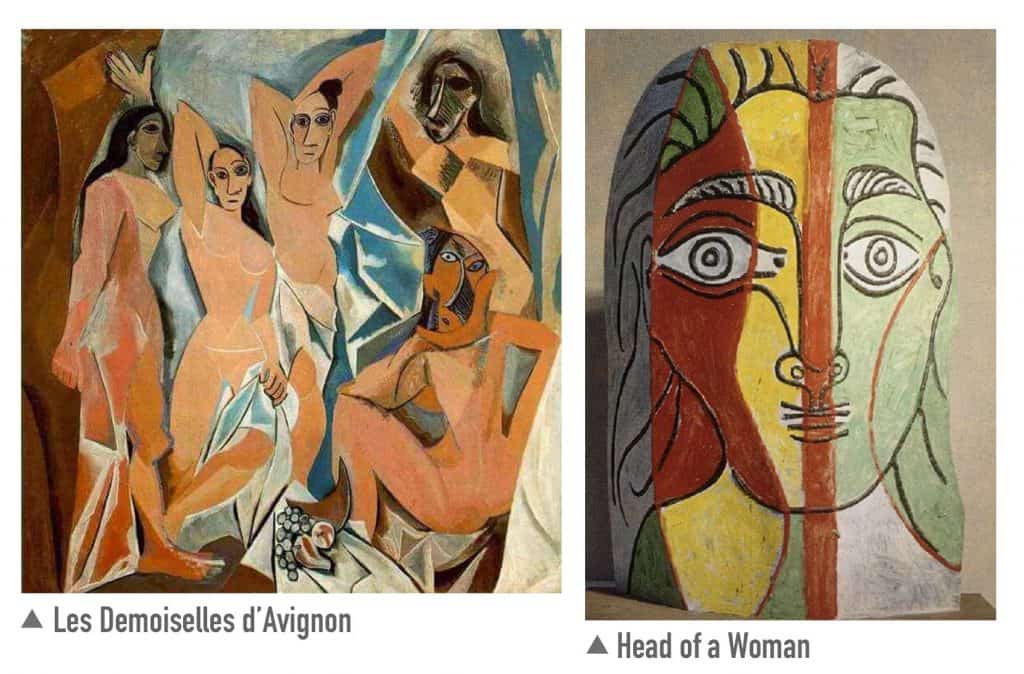
Picasso worked with Georges Braque to develop analytic cubism before WWI.
This marked the beginning of the Cubism school of art, with Picasso and Braque leading the way to take apart the object of their art and analyze them in terms of cubes. Both artists also mainly used brown shades of paint along with other neutral colors during this time. Picasso also made the very first cubist sculpture, Head of a Woman, with his mistress, Fernande Olivier, as the model.
Picasso developed synthetic cubism over most of the 1910s.
This led Picasso to become the first artist to use collage in fine arts, as synthetic cubism involved assembling cut newspaper pages and wallpaper into artistic compositions. Synthetic cubism later evolved into crystal cubism between the years of 1915 and 1917, after Picasso applied synthetic cubism to painting. Two of Picasso’s most popular works during this time were Tête, and his largest painting, Parade.
After WWI he experimented with neoclassicism and surrealism.
He did so as part of the “return to order” movement among artists, which is a reaction to their experiences about WWI. That said, Picasso found neoclassicism not quite appealing to him, and by 1925 had turned to surrealism to better express his creativity. Two of the most popular pieces made in this time period were the Pierrot, Sleeping Peasants, and the sketch Nu féminin assis, from Carnet no. 67.
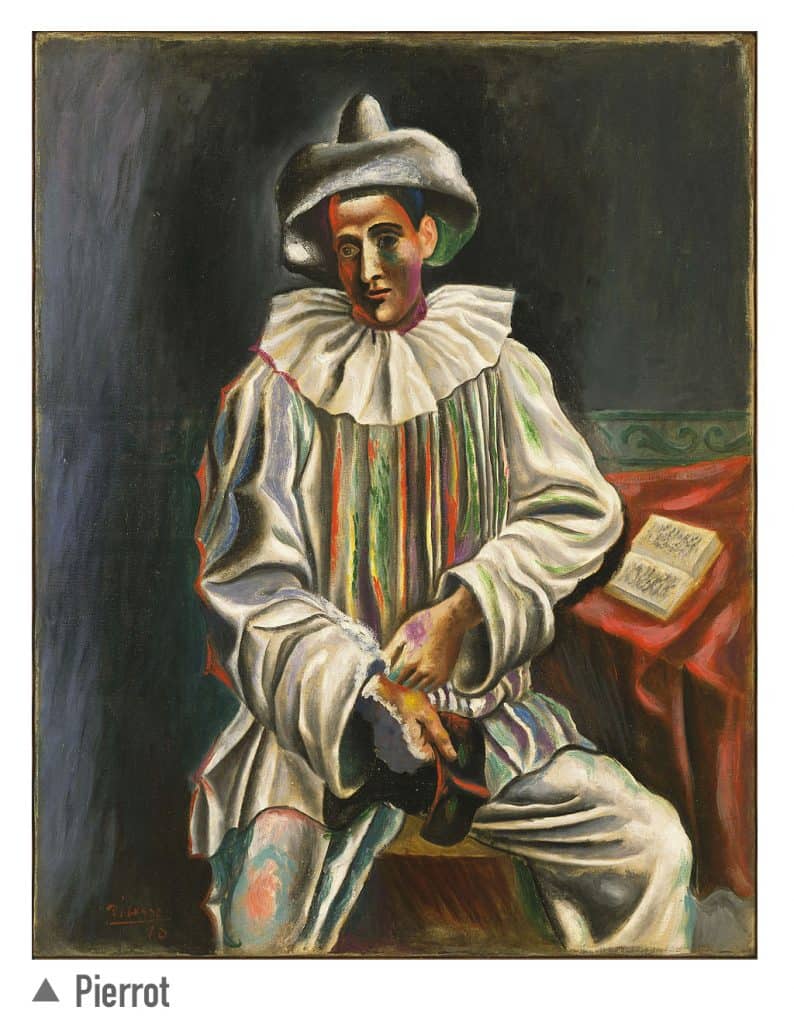
Picasso made his greatest work in the lead up to WWII.
On April 26, 1937, during the Spanish Civil War, German forces allied to Spanish general Francisco Franco bombed the town of Guernica in Basque County. It became the first heavy bombing mission in history, leading the way to the heavy bombing campaigns of WWII. The bombing reduced Guernica to a smoldering ruin and killed over a thousand civilians.
This led Picasso to paint Guernica from May to July, using black and white paint to give it the feel of a historical documentary. The painting showed people and animals blown apart by an explosion. After its completion, Picasso displayed it in Paris as a protest against the war in general and to raise funds for the Spanish Republicans. Today, a tapestry version of the painting rests on a wall outside the United Nations Security Council room to remind people of the horrors of war.
He also dabbled in writing from the 1930s to the 1950s.
Picasso wrote over 300 poems from 1939 to 1959, most of them without titles. Instead, he simply marked them with the time and place of their composition, such as Paris, 16 May 1936. He also wrote his two plays at this time, with the first, Desire Caught by the Tail, written at the height of WWII in 1941. Both his plays and poems had similar themes, such as eroticism and even scatology.
Picasso joined the French Communist Party towards the end of WWII.
He did so in 1944, after the Allied Liberation of Paris. Four years later, he attended the Soviet-backed World Conference of Intellectuals in Defense of Peace. The Soviet government also later awarded him the Stalin Peace Prize in 1950.
Picasso’s association with Communism damaged his relationships, with French poet Andre Breton outright condemning him for it given the Soviet purge of intellectuals in their country. Art critic John Berger proved less confrontational but also described Picasso’s association with Communism as a waste. For his part, Picasso proudly admitted his Communist ties in public, but also said he wouldn’t live his life any differently despite his political leanings.
Picasso continued to experiment with art after WWII.
He started by reinterpreting the works of past art masters, such as Courbet, Delacroix, and Goya, among others. By the 1960s until his death, Picasso produced paintings and copperplate etchings that went unrecognized at the time.
To critics at the time, Picasso’s work clashed with the dominant trends, and so they described his final work as those of an artist past his prime, or even that of an impotent old man. It wasn’t until after he died that they recognized Picasso as a pioneer for the developing school of Neo-Expressionism.
His work at this time includes the Chicago Picasso, which he sculpted under a commission from the city of Chicago. At its completion, though, he refused to accept the $100,000 payment, and instead donated the sculpture to the city.

The Korean War inspired Picasso’s work Massacre in Korea.
Picasso painted it in 1951, as an anti-war portrait inspired by reports of civilian deaths from the Korean War. The painting shows naked women and children standing opposite a firing squad, just moments before their death. At the time, given the strong anti-Communist themes in the West, the painting was received poorly. Today, though, scholars see it as one of Picasso’s greatest works.
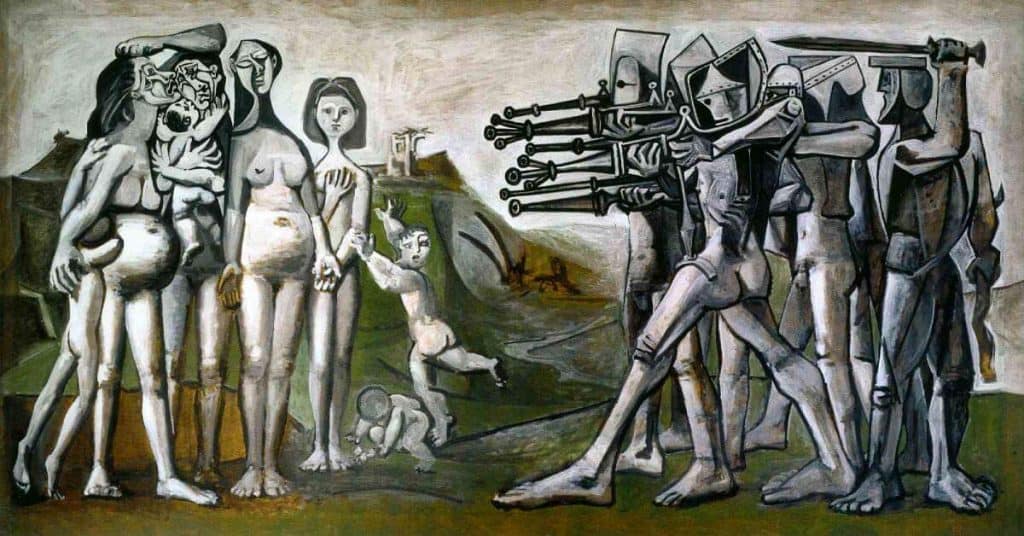
Many of Picasso’s art remains the most expensive in the world.
Garçon à la pipe, for example, which Picasso made in 1905, sold for $104 million in 2004, and set a price record at the time. In 2006, Dora Maar au Chat, which Picasso painted in 1941, was sold for $95.2 million.
Nude, Green Leaves and Bust, which Picasso painted in 1932, broke Garçon à la pipe’s record in 2010, when it sold for $106.5 million. Then in 2015, Picasso’s Women of Algiers became the most expensive painting ever sold, for a price of $179.3 million.
Picasso married twice in his life.
He first married Olga Kokhlova in 1918, and later had a son with her, Paulo. She later attempted to divorce him in 1935, but Picasso refused to divide their property as required by French law. This led them to settle for separation, with Olga staying as his legal wife until she died in 1955.
Picasso later remarried in 1961, to Jacqueline Roque, but had no children with her. Jacqueline clashed with Picasso’s children and grandchildren from other women after his death. Eventually, a French court divided Picasso’s inheritance between the claimants. Jacqueline later committed suicide out of loneliness in 1986.
He also had several mistresses over his life.
He had at least three before he married his first wife, starting with fellow artist Fernande Olivier. By 1915, he’d moved on to Eva Gouel, whose death that year devastated Picasso. He moved on quickly, though, to Gabrielle Lespinasse.
After his marriage to Olga, Picasso largely stayed faithful to her, until he took Marie-Therese Walter as a mistress in 1927. He had one child with her, Maya, born in 1935, who continues to promote her father’s legacy to this day. Picasso had other mistresses after Marie-Therese Walter and had two more children with one of them, Francoise Gilot. His kids were named Claude and Paloma.
Picasso’s opinions on women remained as one of his most controversial traits.
He certainly didn’t hide his womanizing ways, and even admitted to his second wife Jacqueline that he divided women in his eyes between goddesses and doormats. Picasso’s granddaughter Marina also described her grandfather as someone who used the women in his life as a source of inspiration. But once they no longer inspire him, he abandons them like a rag.
Picasso made cameos in a few films during his lifetime.
He did so always as himself, starting with Henri-Georges Clouzot’s biographical film of Picasso himself, Le Mystère Picasso. He also appeared in Jean Cocteau’s Testament of Orpheus in 1960.
American author Ernest Hemingway mentioned Picasso in one of his memoirs.
Specifically, A Moveable Feast, where Hemingway speaks to the art dealer Gertrude Stein about wanting to buy art by Picasso, only he cannot afford them. Hemingway also records in that memoir studying one of Picasso’s works, Young Naked Girl with Flower Basket.
His life has also inspired films and plays.
The 1996 biographical film Surviving Picasso has Welsh actor Anthony Hopkins starring as Picasso himself. The film focuses less on Picasso’s art, and more on his personal relationships, especially with all the different women in his life. Picasso also appeared in the 1993 philosophical play Picasso at the Lapin Agile, alongside Albert Einstein and Elvis Presley.
In the play, both Einstein and Picasso represent genius as born of academic achievement, or as Elvis put it, brains. Elvis, however, represents genius as born purely out of inspiration and passion.
Was this page helpful?
Our commitment to delivering trustworthy and engaging content is at the heart of what we do. Each fact on our site is contributed by real users like you, bringing a wealth of diverse insights and information. To ensure the highest standards of accuracy and reliability, our dedicated editors meticulously review each submission. This process guarantees that the facts we share are not only fascinating but also credible. Trust in our commitment to quality and authenticity as you explore and learn with us.

